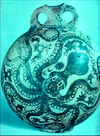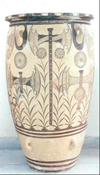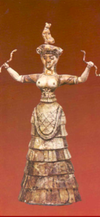Midterm Flashcards
(70 cards)

Name: Sir Arthur Evans
Dates: 1851- 1941
Excavated: Knossos

Name: Heinrich Schliemann
Dates: 1822- 1890
Excavated: Troy, Mycenae, Tiryns, etc.

Name: Christos Tsountas
Dates: 1857-1934.
Excavated: Discovered cultures of Neolithic Thessaly & the Cyclades

Name: Harriet Boyd Hawes
Dates: 1871-1945
Excavated: Gournia

Site: Dmini (Thessaly)
Period: Late Neolithic
Date: 3700-3300 BC
Reconstruction.

Site: Dmini (Thessaly)
Period: Late Neolithic
Dates: 3700-3300 BC
Plan. Note the prominent position of the central building

Period: Late Neolithic
Dates: 4th millenium
Found: Dmini (Thessaly)
Materials: ceramic, handmade
Shape: Jar

Period: Neolithic
Dates: 4th millenium
Found: Crete
Materials: ceramic, incised
Shape: pyxis
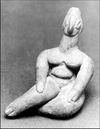
Type: Figurine
Period: Middle Neolithic
Dates: 5th millenium BC
Found: Pharsala (Thessaly)
Materials: terracotta

Type: figurine
Period: Early Neolithic
Dates: 6000 BC
Found: Nea Nikomedia (Macedonia)
Materials: terracotta

Site: Myrtos, Fournou Koriphi
Period: EM II
Dates: 2600-2300 BC (built & destroyed)
Plan and two views. Only fully excavated Minoan village.

Ware: Ayios Onoufrios
Period: EM
Dates: 2700 BC

Ware: Vasiliki
Period: EM II
Date: 2500 BC

Building: House of the Tiles
Site: Lerna (Argolid)
Period: Early Helladic II
Date: 2900-2400 BC
Plan and reconstrution.

Type: “Urfirnis Sauceboats”
Period: Early Helladic
Date: 3000 - 2200/2000 BC
Shape: zoomorphic (bird)
Same shape also occurs in metal.

Type: “frying pan”
Period: Early Cycladic II
Date: 2500 BC
Found: Chalandriani, Syros (island)
Materials: clay
Decoration: incised white-filled spirals, profile of ship

Period: Early Cycladic II
Dates: 2500 BC
Found: Chalandriani, Syros (island)
Decoration: dark paint on light ground

Type: figurine, folded arm variety
Period: EC generally, this EC II
Material: Marble

Type: figurine, violin-shaped variety
Period: EC generally, this EC I
Material: marble

Type: figurines, Louros type
Period: EC generally, these EC I
Material: marble

Type: figurines, musicians (harp & aulos players)
Period: EC generally, these EC II
Found: Keros
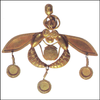
Description: Gold pendant in form of two bees with globe of honey
Period: Early Minoan
Date: 3rd millenium BC
Found: Chrysolakkos cemetery @ Mallia
Material: gold
Technique: goldwork, filigree and fine granulation

Structure: tholos tomb
Site: Kamilari (south-central Crete)
Period: EM II
Date: 2500-2200 BC
Plan and view.

Name: Phaistos Disk
Period: MM IIIB (New Palace)
Dates: 1700-1600 BC
Found: Phaistos
Both sides. Undeciphered. Impressed with pictographic signs arranged in a spiral and divided into groups by traverse lines.














